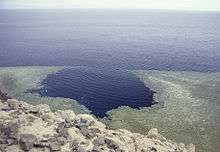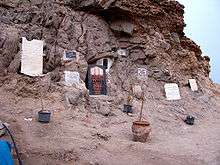Blue Hole (Red Sea)

Blue Hole is a diving location on east Sinai, a few kilometres north of Dahab, Egypt on the coast of the Red Sea.
The Blue Hole is a submarine sinkhole, with a maximum depth within the hole of just over 100 m (328 feet). There is a shallow opening to the sea around 6 m (20 feet) deep, known as "the saddle", and a 26 m (85 feet) long tunnel, known as "the arch", whose top is at a depth of 56 m (184 feet), and whose bottom falls away as it reaches the seaward side to about 120 m (394 feet).[1] On the seaward side the depth drops steeply to over a thousand metres (3500 feet) deep. [2] The hole and the surrounding area have an abundance of coral and reef fish. [3]. The Blue Hole is a hot spot for freediving because of the depth directly accessible from shore and the lack of current.
The Blue Hole at Dahab is believed to be by far the most dangerous and deadliest dive site in the world,[4] having claimed the lives of over 130 divers in recent years.[5][6] The reasons why this site is the most dangerous in the world are not clearly understood,[7] with differing explanations given for its high death rate. There is a local legend that the Blue Hole is cursed by the ghost of a girl who drowned herself there to escape from an arranged marriage.[6]
Diving History

The Blue Hole was historically avoided by Bedouin tribes people who inhabited the area. However, the Sinai Peninsula was conquered by Israel during the Six-Day War of 1967. The first people to dive the hole with scuba equipment were Israeli divers led by Alex Shell, who discovered the underwater arch in 1968. By the time Israel handed the Sinai Peninsula back to Egypt in 1982, the Blue Hole had already developed a reputation as a diving site amongst the Israeli and international diving community.
Dangers
The Blue Hole is dived almost every day by recreational divers. Local dive centres take divers who are qualified to dive to 30m to do the site known as El Bells or Bells to Blue Hole. The entry is further along from the Blue Hole at an entry called The Bells. At 26m at the bottom of the Bells is a mini arch that should not be confused with the arch in the Blue Hole itself. The dive is then a wall dive that finishes crossing the Blue Hole saddle at a depth of 7m. Recreational divers do not get to see the Blue Hole arch when doing the Bells to Blue Hole dive.
However, the Blue Hole is notorious for the number of diving fatalities which have occurred in the past. The Egyptian authorities claim that 40 divers have died since the 1980s.. Another source puts the number of deaths over 130, and notes that it is the most deadly dive site in the world. [8]
Accidents happened as divers tried to find the tunnel through the reef (known as "The Arch") connecting the Blue Hole and open water at about 52 m (170 feet) depth. This is beyond most recreational diving limits and the effect of nitrogen narcosis is significant at this depth. Divers who missed the tunnel sometimes continued descending, hoping to find the tunnel farther down and became increasingly narcosed; furthermore, the rate of consumption of air by an open-circuit diver increases the deeper the diver descends.

The "Arch" is reportedly [6] extremely deceptive in several ways:
- It is difficult to detect because of the odd angle between the arch, open water, and the hole itself.
- Because of the dim lighting, most light entering from outside through the arch and lack of reference points, it appears shorter than it really is. Divers report that the Arch appears less than 10 m long but measurements have shown it is 26 m long from one end to the other.
- There is frequently a current flowing inward through the arch towards the Blue Hole, increasing the time it takes to swim through.
- The arch continues downward to the seabed which is beyond view and there is therefore no "reference" from below.
- In the very clear Red Sea water, the arch may seem to be nearer and smaller than it is.
- The diver's mind may be muddled by nitrogen narcosis.

Divers who resist the temptation of the Arch and remain within their training and limitations are in no more danger than on any other Red Sea dive site. However, the Arch has proved irresistible for many and thus the dive site is considered unsuitable for beginners and a potential trap for even experienced divers. The Egyptian Chamber For Diving & Watersports (CDWS) now has a policeman stationed at the Blue Hole to ensure divers are diving with a certified guide to ensure safety procedures are followed.

Diving through the arch requires suitable training and equipment, usually including a mixed-gas qualification from a technical diving training agency, technical diving equipment such as redundant gas supply, redundant large-capacity buoyancy control device and a breathing gas with reduced oxygen and nitrogen content such as trimix.
Deaths
It is believed that over 130 divers have died while at the site in recent years.[9] It is far more deadly than any other diving site in the world.[10] The Egyptian authorities claim that 40 divers have died at this site since the 1980s. As a result of its death rate, Egyptian authorities only allow access to the site to qualified divers who dive alongside certified diving instructors.
Yuri Lipski
Yuri Lipski (1 October 1977- 28 April 2000), a 22 year-old Russian-Israeli diving instructor, died at a depth of 115 metres underwater[11] after falling into an uncontrolled descent, notably filming his own death with his video camera.[12] The video footage shows him rapidly plunging deeper and deeper, in an involuntary and uncontrolled descent to 115 metres. Eventually he lands on the sea floor, taking off his breathing equipment and trying to fill his buoyancy aid with air, but he is unable to rise. At the depth to which he fell, the body is subject to nitrogen narcosis, which can impair judgment and induce overconfidence, euphoria, hallucinations and confusion. Lipski had just one tank full of air — technical divers are better served by multiple tanks filled with trimix, a combination of oxygen, nitrogen, and helium that reduces narcosis.
The next day, Lipski's body was recovered by Tarek Omar, one of the world's foremost deep-water divers, at the request of Lipski's mother.[13] Omar had earlier warned Lipski against attempting the dive when he met him on two earlier occasions, but to no avail.
At the bottom of the ocean, Omar found Lipski's helmet camera was still intact. Omar says:
| “ | “Two days after we recovered his remains and gave [his mother] his belongings and equipment, she came to me asking that I help her disassemble them so she can pack them. The camera should have been damaged or even broken altogether because I had found it at a depth of 115 metres, and it is only designed to sustain 75 metres; but, to my surprise, the camera was still working. We played it and his mother was there. I regret that his mother will have this forever... If I had known the footage existed I’d have flooded it. I think the thing that really upset and saddened me about it was that his mom has it now – she has the footage of her own son drowning”[14] | ” |
The footage from the camera is available on YouTube, entitled "Fatal Diving Accident Caught On Tape". The footage shows a routine dive deteriorating into panicked thrashing as he becomes more disoriented, while clouds of kicked-up sand come into view as Lipski's breathing rate doubles. In the end, he removes the breathing apparatus from his mouth and the frame goes still.[6]
Coordinates: 28°34′19.99″N 34°32′14.55″E / 28.5722194°N 34.5373750°E
References
- ↑ "Blue hole maps". Archived from the original on March 21, 2008.
- ↑ A Visit to the World's Deadliest Dive Site July 13, 2012, Der Spiegel | accessdate = July 7 2017
- ↑ A Visit to the World's Deadliest Dive Site July 13, 2012, Der Spiegel
- ↑ A Visit to the World's Deadliest Dive Site July 13, 2012, Der Spiegel
- ↑ A Visit to the World's Deadliest Dive Site July 13, 2012, Der Spiegel
- 1 2 3 4 Monty Halls and the Divers' Graveyard, Channel 5 (UK) television, 9pm to 10pm, Monday 2 December 2013
- ↑ A Visit to the World's Deadliest Dive Site July 13, 2012, Der Spiegel
- ↑ A Visit to the World's Deadliest Dive Site July 13, 2012, Der Spiegel
- ↑ A Visit to the World's Deadliest Dive Site July 13, 2012, Der Spiegel
- ↑ A Visit to the World's Deadliest Dive Site July 13, 2012, Der Spiegel
- ↑ A Visit to the World's Deadliest Dive Site July 13, 2012, Der Spiegel
- ↑ EGYPTIAN DIVER TAREK OMAR: THE KEEPER OF DAHAB'S DIVERS' CEMETERY NIVEEN GHONEIM, 20/10/2016
- ↑ EGYPTIAN DIVER TAREK OMAR: THE KEEPER OF DAHAB'S DIVERS' CEMETERY NIVEEN GHONEIM, 20/10/2016
- ↑ EGYPTIAN DIVER TAREK OMAR: THE KEEPER OF DAHAB'S DIVERS' CEMETERY NIVEEN GHONEIM, 20/10/2016
External links
- Graphic: The Blue Hole in the Gulf of Aqaba. Diagram showing location of the arch.